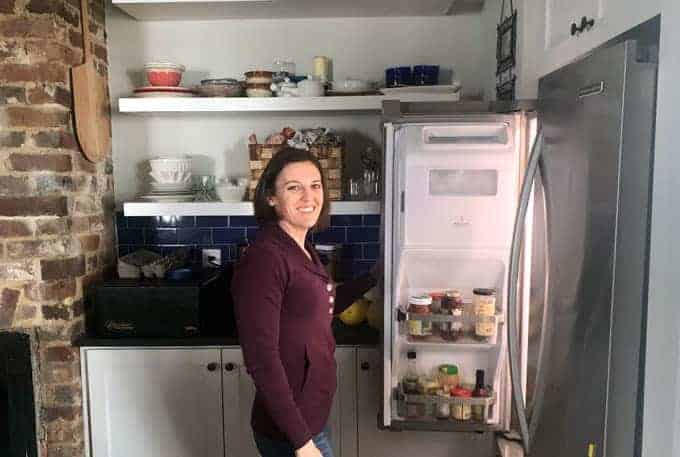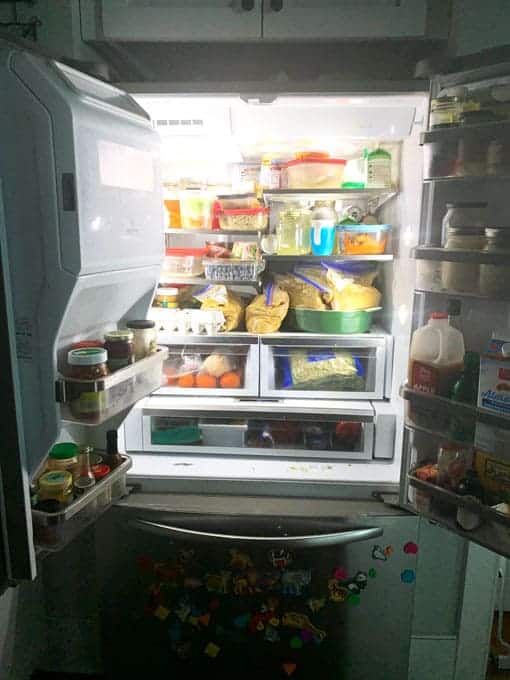How do you know what to buy and what to eat to maintain a healthy, clean eating lifestyle? Here's a peek into my fridge, plus my favorite brands for clean and sustainable products and a real food grocery list to help you get started!

Recently, someone asked me if I was still counting macros or doing Whole30 cycles, or if I had moved on from being so strict. Their question got me thinking of how I got started on my clean eating journey, and where I am on it now.
I started changing my eating habits before I knew what a profound difference it would make in my life. After realizing how much better I felt with paleo and clean eating, I slowly began to adopt it as part of my lifestyle.
Years later, when we were trying to get pregnant, I was diagnosed with PCOS. This caused me to dial in even further on my diet, focus on anti-inflammatory foods, and work to heal my body naturally.
At the time it helped me take control of my health, learn about the power of nutrition, and the way that food can really nourish your body. (And, spoiler alert, I got pregnant two weeks before a scheduled IVF trip, so it really does work!)
Now, while I still believe all of those things, I take a less extreme approach to my diet. I’m learning how to take a more intuitive approach to the foods I'm eating, because I’ve realized how much stress and your relationship to food can impact things like digestion and hormones–oftentimes even more than the actual food itself!
I still eat mostly paleo, or my version of it, most of the time. I keep nourishing foods on hand and work hard to avoid a lot of highly processed convenience foods.
And while I do try to take a mostly ‘real food’ approach when I’m eating at home and find foods with a minimal ingredient list, and little to no artificial ingredients, fake sweeteners, or questionable preservatives, I remind myself daily that it’s not about being perfect.
It’s not worth it to stress over every little thing that touches your lips. Overall, it’s about making the best food choices that you feel support your health, especially when you’re at home and you can really be in control of what you eat, without bringing out your inner drill sergeant.
If you're just getting started on your real food journey, don't try to change everything at once. It will set you up for failure, guaranteed. Instead, start small. Change one item in your fridge or pantry that you can make a healthier choice for. Focus on progress, not perfection!
Where to shop for healthy food
I do a ton of my shopping online to save time. Amazon and/or Amazon Subscribe & Save and Thrive Market are my go-tos.
Whole Foods and Earth Fare for perishable goods, produce and meat. You can even shop at Amazon Fresh /or Amazon Prime Now, which now offers Whole Foods’ house brand of products.
We also use Trader Joe’s, Publix on occasion, and love hitting up local farmer's markets for fresh, local produce.
So, let’s get into it, shall we?
What's in my fridge
Fresh Organic + Seasonal Produce: Regardless of your dietary preferences or popular diets (keto, vegan, Whole30, etc.), I think we can all agree that fruits and vegetables are the most important thing to nourish our bodies.
I like to keep my fridge stocked with a rotating selection of organic produce. I always have bags of organic spinach and other leafy greens, broccoli, cauliflower, brussel sprouts, peppers, carrots, fresh berries, citrus (lemons, limes, oranges), and apples in my fridge.
Of course, these change depending on what’s in season, which results in fresher food for less money.
For example, I focus on things like squash and cabbage in the fall and berries in the summer, as they are at their freshest, and also at their best price!
Organic, Pasture-Raised Eggs: Eggs are easily my favorite thing to eat for breakfast, or really any time of day. I am lucky enough that I often get eggs from a local farm or even a friend's chickens, but when those aren't available, I try to make sure I buy the organic variety from the grocery store.
Organic, Pasture-Raised Meat: People think paleo means you have to eat a lot of meat. It doesn't. I easily eat three to four times as many vegetables as I do meat. That being said, I do enjoy protein with my meals.
At our house, we focus on smaller portions of higher quality meats - organic, grass-fed or pasture-raised options, which are better for you, the animal and the environment.
My favorite meats to buy are boneless chicken breasts, ground pork, ground beef, boneless skinless chicken thighs, and pork chops.
My go-to source for these clean meats is ButcherBox. They always offer something free in your box depending on the season, so check their site to see what they're offering right now, and jump on it!

Non-Dairy Milks: I don't really eat or drink dairy very often. I use Organic Valley’s Grassmilk half and half in my coffee in the morning, but outside of that I don't really buy or consume dairy products.
We do keep the trusted grass-fed Kerrygold butter in our fridge for occasional use, but butter has such a low smoke point that I usually cook with something like avocado or coconut oils. We keep unsweetened, unflavored almond milk in our fridge at all times for my son, and we also use it in our smoothies and protein shakes.
We also use coconut milk in recipes and in smoothies. I prefer the Native Forest or Thai Kitchen brands, as they are free of additives.
Other Drinks: When it comes to drinks, I stick with filtered water 99% of the time. But when I need a bit of flavor, I opt for sparkling water, herbal teas, and kombucha (which I started drinking when working on my gut health - I couldn't stand it and now I love it!)
GT’s Synergy is my favorite brand. We occasionally also have coconut water on hand, which my son adorably calls "tea."
Alcohol: I get asked a lot if alcohol is paleo. No, alcohol is not paleo. There's not really anything healthy about alcohol. That being said, I'm also a big promoter of all things in moderation and not giving up the things you enjoy, as long as you can find balance. So how does alcohol fit into my lifestyle?
I've never been a big wine drinker. I can appreciate it in certain settings or on certain occasions, but it's not my go-to. I also have never acquired a taste for beer. Which leaves me with...liquor.
If I'm having a drink, it is typically either bourbon, tequila, or rum, in the form of an Old Fashioned, a Classic Margarita, or a Dark n' Stormy. Usually after one drink I'm done.
We do attend the occasional happy hour, which might result in 2 drinks. I honestly just don't find drinking to be worth it much anymore. The older I get, the worse I feel the next day (or two!) and the benefits just don't outweigh the aftermath.
Also, I'd much rather use my calories on dessert, something like Almond Butter Swirl Brownies or Chocolate Avocado Pudding.
Condiments: Oh, the condiments. I've gotten to a point where I make most of my own. It's taken years of practice, so don't put too much pressure on yourself to get there.
It's a slow part of the process and will come in time (or maybe it won't, and that's ok too!) If you're buying store-bought, you want to try and avoid any junk oils like canola and soybean. (If you're not familiar with healthy vs. unhealthy fats, you can read more about them here.)
If you're ready to try your hand at making your own, here is my mayo recipe and my ranch dressing recipe. Danielle over at Against All Grain has perfected the ketchup recipe, and I use hers regularly. It makes 2 small mason jars worth, so I stick one in the fridge and freeze the other, and maybe make it 2-3 times a year.
Salad dressings are usually just a mix of Kasandrino's olive oil and either balsamic, white wine, or other vinegar with a few spices.
If you're looking for clean versions, but store-bought, here are my recommendations:
Mayo: either Primal Kitchen or Chosen Foods
Ketchup: Primal Kitchen or Paleo Chef
Salad Dressings and Marinades: Tessamaes or Primal Kitchen
What's in my freezer
Frozen Fruit and Veggies: Just like my fridge, my freezer is stocked with tons of produce. I love using frozen fruit in my smoothies–it makes them icy cold without watering them down with ice cubes. Plus, frozen fruit is picked at the peak of seasonal freshness and frozen on the spot, so it’s actually fresher and more flavorful than regular fruit.
I keep frozen veggies in my freezer to add to soups and stir-frys. Some of my favorites include broccoli, cauliflower, mixed veggies, spinach, artichokes, peppers and carrots. My son especially loves the Trader Joe's frozen Carrot Spirals!
Wild, Sustainable Seafood: Living by the water, we are incredibly lucky when it comes to seafood. We are members of a CSF, or Community Supported Fishery, called Abundant Seafood.
This means we purchase shares at the beginning of the season to provide support for the fisherman, and he then goes out to catch fish, and we come and pick it up at the dock when he comes in. It doesn't get much fresher than that!
I realize that not everyone has options like that. For wild-caught salmon and scallops, you can’t find a more sustainable or delicious option that Butcher Box. I'm also a big fan of US Wellness Meats. While they have lots of meat options, they also carry a sustainable seafood line.
Homemade Broth: One of the most nourishing and healing foods on the planet! Anytime we cook chicken or beef, I’ll make a big pot of homemade stock to keep in my fridge and freezer.
A great easy way to do this is to buy a rotisserie chicken at the store, then save the carcass. Stick it in the Instant Pot with some water, veggies, and spices, and let it go for a few hours, low and slow. Hands-off homemade broth!
Sometimes I’ll just drink this plain, but more often I add it to soups, stocks & sauces, like my Creamy Broccoli Soup or my Curried Sweet Potato Soup.

Healthy grocery list
I hope some of the above is helpful! These anti-inflammatory foods are how I keep my fridge stocked so that healthy meals are always quick and easy to make, which is key when you are busy.
To help you stock your own fridge full of foods that will reduce inflammation, I’ve created a real food shopping list you can take with you to the grocery store. You can snag it in my FREE Resource Library below!
What’s in your fridge? Share in the comments below. I’d love to hear from you!





Leave a Reply